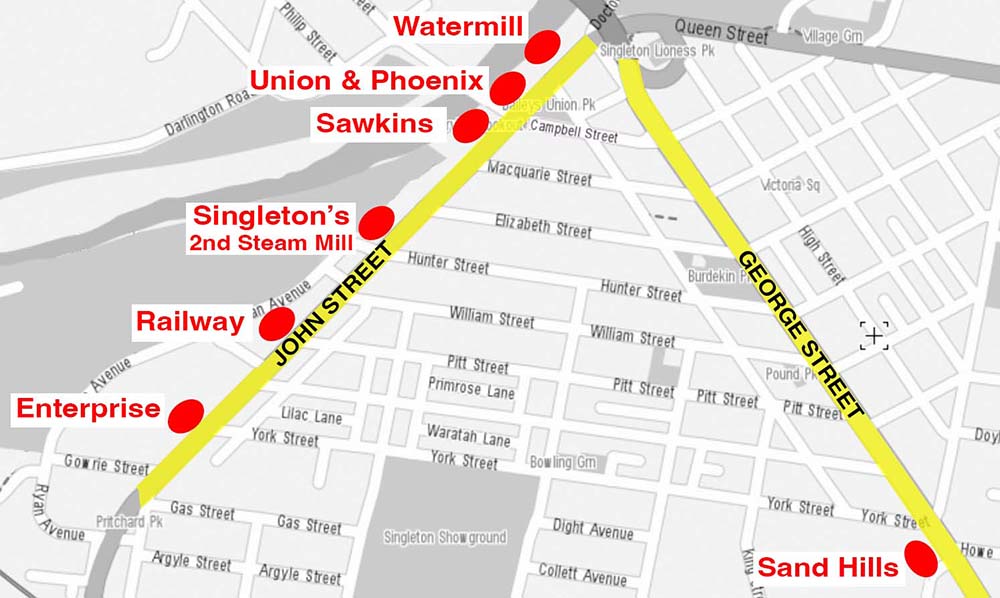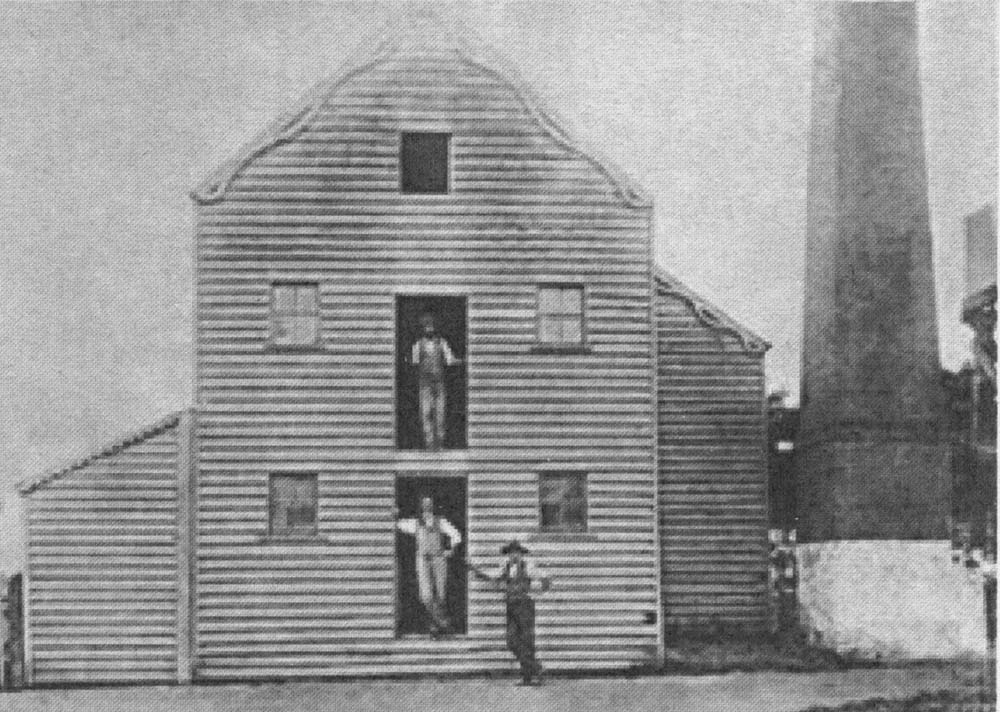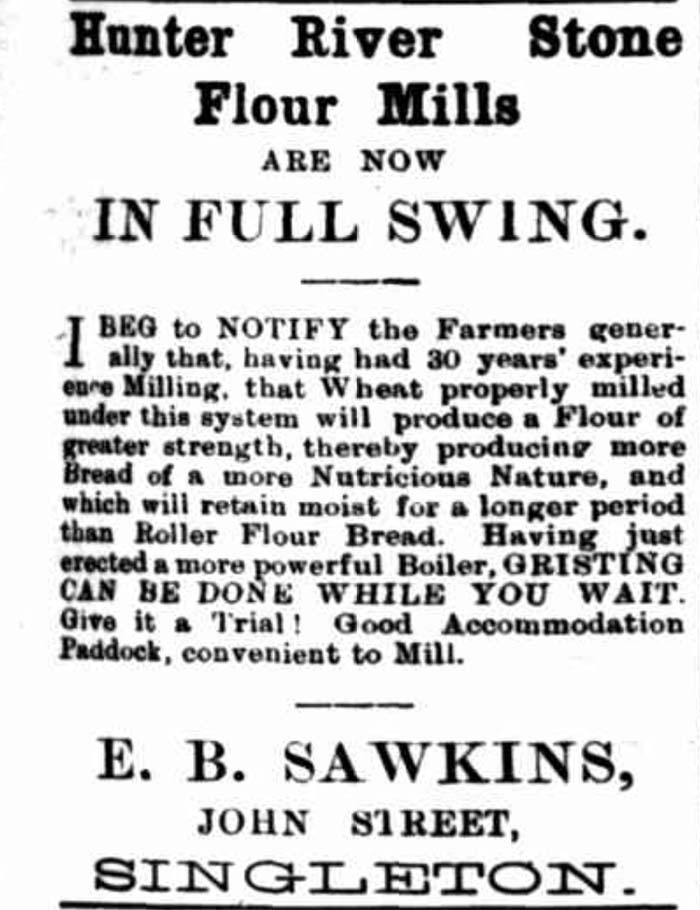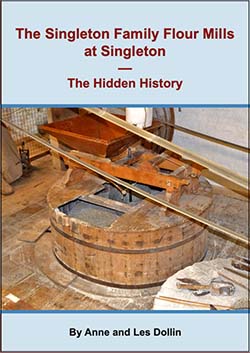
The Sawkins Milling Operations in Singleton --
Thomas and E. B. Sawkins
aka Sawkins' Mill, The Hunter Valley Mill
Singleton Mills homepage > Mills at Singleton > The Sawkins Milling Businesses in Singleton
Thomas Sawkins (1800 – 1882) was an experienced miller who, had previously operated two flour watermills established by the Singleton family near Wisemans Ferry. [1]
Thomas Sawkins and his son, Edwin Benjamin Sawkins (usually known as E. B. Sawkins ), milled flour in Singleton, NSW, for about 40 years.
First Operation:
A lease on Benjamin Singleton Junior's mill in George Street
In 1860, Benjamin Singleton Junior established a steam flour mill in an area known as the Sand Hill or the Sand Hills in George Street, Singleton. He leased this mill to Thomas and E. B. Sawkins for eight or nine years. [2]
During this period, this mill was sometimes known as the 'Sawkins Mill'.
To read the full story of Benjamin Singleton Junior's Steam Flour Mill at the Sand Hills in George Street and other mills established by the Singletons, download our free PDF: The Singleton Family Flour Mills at Singleton – |
Second Operation:
A mill established by E. B. Sawkins in John Street
In 1873, E. B. Sawkins had established a bakery in John Street, Singleton. [3]
He also invited tenders to erect a wooden and galvanised iron building in 1873. [4]
Then in 1874, E. B. Sawkins established his own steam flour mill in John Street, Singleton.

The locations of eight mills built in Singleton township in the 1800s.
In August 1874, he published an announcement that he was moving his milling business there:
"Hunter River Flour Mill, JOHN STREET, SINGLETON – The undersigned begs to thank the inhabitants of the District for their liberal support at the Mill lately occupied by him at the Sand Hills, George-street, and begs to inform them that, having erected a new Flour Mill in John-street, Singleton, next to his Bakery, that it is now ready for work. Grist executed with despatch, and every pains taken to give satisfaction. E. B. SAWKINS. ON SALE. – FLOUR, Flour – Superfine and Household – of superior qualities ; also Bran, Pollard, Maize, white and yellow Maize Meal, at current rates. E. B. SAWKINS, Hunter River Flour Mill." [5] |
Edwin Sawkins named his mill, the 'Hunter River Flour Mill' but it was also sometimes called 'Sawkins' Second Mill'.
Description of Sawkins Mill in John Street
Key Facts about the Sawkins Mill in John Street Our research indicates that this mill, on the northwestern side of John Street, Singleton, was on two adjoining allotments of land with a combined frontage of 162 feet (49 metres) and size of five acres, between the intersections of Macquarie Street and Campbell Street. The mill building was made of weatherboard with two storeys and an attic (three floors). A bakery, a two-storey brick store and a residence were also built on the same land. [6] The steam engine was eight horse power and it had two pairs of millstones. [7] |

Sawkins Steam Flour Mill in John Street, Singleton. Notice the attractive decorative trims on this weatherboard mill. Image courtesy of the Singleton Historical Society & Museum.
A detailed description of Sawkins' Mill was published in 1875:
"SAWKINS' MILL. This is a new wooden mill, also facing John-street. It was erected only six months ago. Mr. Thomas Sawkins' the father of the proprietor of the present mill, carried on business for eight or nine years in a building near the sandhills. Mr. E. B. Sawkins is carrying on the new mill on his own account. The engine is 8 horse-power, and the boiler, which is a Cornish one, will hold 1200 gallons. There are two pair of stones ; one of them is a large pair, and the other small. The smutting machine is outside the mill, the same being a very good arrangement, as the mill is not rendered disagreeable by the dust. It is a wire dressing machine that is in use. The sack tackle will hoist both up and down … We shall think that the three mills [two other mills, the Phoenix Mill and Achurch's Mill, were described in the same newspaper issue] ought to be quite adequate to grind all the wheat in the Patrick's Plains district ; each of the mills is doing a steady trade…" [7] |
In 1897, E. B. Sawkins improved his Hunter River Mill:
"Important Milling Notice – I have much pleasure in announcing that my MILL now undergoing improvements will be ready to start in about a week. I am prepared to receive Wheat when I trust to see all my old customers, as well as new ones, roll up with their Grists. Every care will be taken to give satisfaction. Farmers from long distances can rely upon a quick despatch. Good accommodation paddock handy to Mill. ....E. B. SAWKINS. John-street, Singleton." [8] |
However, on 10 September 1898, the bakery and the whole milling concern was advertised for sale. The property was described as follows:
"For Sale by Public Auction. -- An allotment of land, situate in Singleton, having a frontage of 162 feet to John-street by a depth of 165 feet, upon which are erected a two-storey brick Store and Dwelling, Bakery and Flour Mill, all in good repair ; also machinery and working plant of said mill, consisting of Boiler, Engine, Dresser, Appliances, etc. The property is now occupied by Mr E. B. Sawkins, who has the whole concern in first-class working order." [9] |
Apparently, he did not find a buyer, because in December 1898, E. B. Sawkins advertised that his Hunter River Stone Mills were again in operation. It is interesting that he also was promoting the benefits of his stone-ground flour as being better than roller-milled flour – probably since a competitor, the Enterprise Flour Mill, equipped with a modern Roller Mill, was also then operating in John Street:
"Hunter River Stone Flour Mills ARE NOW IN FULL SWING. -- I BEG to NOTIFY the Farmers generally that, having had 30 years' experience in Milling, that Wheat properly milled under this system will produce a Flour of greater strength, thereby producing more Bread of a more Nutricious [sic] Nature, and which will retain moist for a longer period than Roller Flour Bread…." [10] |

Above: this advertisement, explaining the superior qualities of stone flour produced by Sawkins' Hunter River Mills, was placed in the Singleton Argus on 10 December 1898.
Later history of the Sawkins Mill in John Street
Edwin Benjamin Sawkins died on 12 December 1905, aged 58. His obituary stated:
"He learned the milling business from his father [Thomas Sawkins], who was a skilled miller, and later the deceased went into business for himself in John-street… The whole of the machinery in the mill he put together himself, and has been complimented several times by engineers upon the expert manner in which the machinery was put together." [11] |
Edwin's widow, Essay Sawkins, advertised the mill property and bake house for sale in 1908 and 1909. [12] Evidently, some sawmilling capability had been added to the mill between 1898 and 1908.
The 1909 sale description stated:
"ABSOLUTE SALE ... All that Property in John-street, Singleton, known as Sawkins' Mill, Residence, and Bakery, and having a frontage to John-street of 162ft., with a depth of 165ft. The Mill is a Weatherboard structure, comprising Three Floors, and has in it necessary Mill Appliances, Lifts, Etc., as well as a Circular Saw Plant and a Tangye Pump. The Residence is a Two storied Brick Structure of 8 Rooms. Underneath the Residence is a shop, formerly used as a Flour Store, 27ft. x 16ft. Kitchen Outhouses, Etc., are connected with the Residence, which can be made into two if necessary. A Weatherboard Bakehouse is also on the Premises with Oven and all necessaries." [13] |
Essay Sawkins advertised the mill property for sale again in 1911 and finally sold the property to Henry Storey and Walter Smith on 15 August 1911. [14]
Two decades later, in 1934, a Municipal Council gang were working outside the John Street depot, on a drainage pit to service Macquarie and Campbell Streets. They unearthed an immense and deeply buried beam. They concluded that this was part of the foundations of the old flour mill of Mr E. B. Sawkins, that once stood on the site. The timber was still in excellent condition. They also found an 1857 penny, and closer to the river, some solid brick foundations. [15]
Researched by Anne and Les Dollin
References
1. Clayworth, Dot. (2015) The Flour Mills of Singleton (Part 4). The Hunter River Stone Flour Mill. The Singleton Times (Newsletter of the Singleton Historical Society), Issue 120, pp 3-6.
2. The Singleton Argus and Upper Hunter General Advocate, 6 February 1875
3. The Maitland Mercury and Hunter River General Advertiser, 4 September 1873
4. The Maitland Mercury and Hunter River General Advertiser, 23 October 1873
5. The Singleton Argus and Upper Hunter General Advocate, 12 August 1874
6. Singleton Argus, 24 April 1909 and 22 July 1911
7. The Singleton Argus and Upper Hunter General Advocate, 6 February 1875
8. Singleton Argus, 11 December 1897
9. Singleton Argus, 10 September 1898
10. Singleton Argus, 10 December 1898; Clayworth, Dot. (2015) The Flour Mills of Singleton (Part 4). The Hunter River Stone Flour Mill. The Singleton Times (Newsletter of the Singleton Historical Society), Issue 120, pp 3-6.
11. Singleton Argus, 14 December 1905
12. Singleton Argus, 21 November 1908, 24 April 1909 and 22 July 1911
13. Singleton Argus, 24 April 1909
14. NSW Lands Conveyance Document, Book 942, Number 748
15. Singleton Argus, 6 June 1934.
Further Reading
• Overview of Mills at Singleton • The Kurrajong Mills • The Wisemans Ferry Mills
